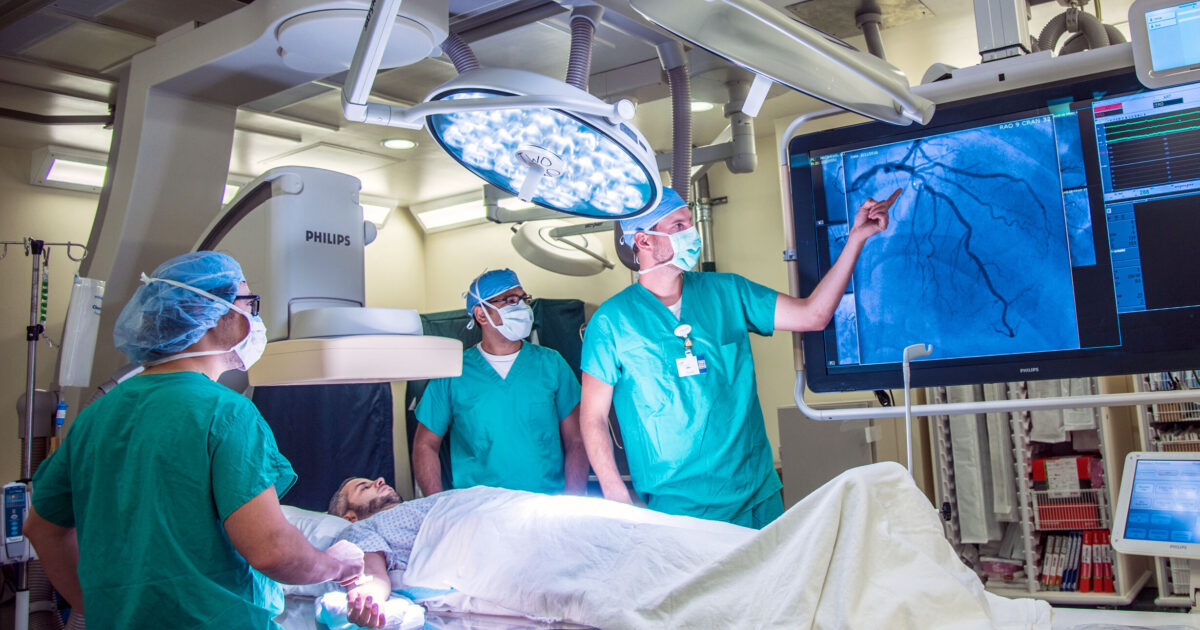How Cardiology care shields your cardiovascular health long-term
How Cardiology care shields your cardiovascular health long-term
Blog Article
Recognizing the Importance of Cardiology in Modern Healthcare Providers
Cardiology plays an essential function in modern healthcare, especially as heart disease remains to be the leading source of death worldwide. Advancements in diagnostics and therapy have actually transformed client treatment, enabling earlier treatments and enhanced outcomes. Moreover, the shift towards preventive cardiology equips people to handle their wellness proactively. As modern technology proceeds to advance, the assimilation of innovative solutions may further redefine cardiology's influence on public wellness, prompting a more detailed examination of emerging fads and their implications.
The Prevalence of Heart Illness and Its Effect on Public Health
Although heart problem remains the leading reason of death around the world, its impact extends far past private patients to impact public health and wellness systems and economic climates. The high occurrence of heart disease puts a substantial strain on medical care sources, necessitating enhanced funding for avoidance, therapy, and rehabilitation programs. Public health and wellness initiatives need to attend to threat factors such as excessive weight, cigarette smoking, and sedentary way of livings, which add considerably to the rising incidence of heart conditions.Moreover, the economic burden related to heart problem is tremendous, including not only straight medical costs but likewise indirect expenditures associated to shed efficiency and early death. Communities deal with obstacles in managing these expenses, typically bring about disparities in medical care gain access to and outcomes. As the population ages and lifestyle-related threats continue to intensify, the urgency for efficient cardiology interventions becomes critical. Attending to heart condition is not only an issue of specific health yet additionally a critical public health and wellness top priority.
Advancements in Cardiac Diagnostics and Imaging Techniques
Current innovations in cardiac diagnostics and imaging strategies have actually revolutionized the area of cardiology, enhancing the capability to monitor and discover cardiovascular disease. Strategies such as heart MRI, CT angiography, and echocardiography have actually become progressively advanced, offering thorough photos of cardiac frameworks and functions. These techniques permit the early recognition of problems like coronary artery disease, cardiac arrest, and valvular disorders.Moreover, innovations in non-invasive diagnostics, such as wearable modern technology and remote surveillance devices, have encouraged people and doctor. These devices promote real-time tracking of heart rhythms and various other vital signs, resulting in prompt treatments. In addition, man-made knowledge is being integrated right into imaging evaluation, improving accuracy and performance in diagnosis.
Developments in Treatment Alternatives for Heart Issues
Recent advancements in cardiology have resulted in significant developments in treatment choices for heart disease. These consist of innovative surgical methods that enhance step-by-step end results and emerging drugs that supply new avenues for treatment. As the area develops, these innovations play an important role in boosting patient care and results.
Advanced Surgical Techniques
Technologies in medical methods have transformed the landscape of cardiology, using new hope for individuals with heart problems. Minimally intrusive treatments, such as catheter-based treatments, have actually greatly lowered recuperation times and hospital remains. Methods like robotic-assisted surgical treatment boost accuracy, permitting cosmetic surgeons to browse intricate anatomical structures with greater accuracy. Advancements in imaging modern technology facilitate real-time visualization during procedures, enhancing results. Transcatheter aortic valve substitute (TAVR) exhibits a breakthrough in dealing with aortic stenosis, enabling valve replacement without open-heart surgery. Furthermore, hybrid approaches that incorporate catheter-based and medical techniques offer customized options for different heart issues. These innovative medical strategies not only boost person security yet additionally broaden therapy options, underscoring the crucial duty of development in modern-day cardiology methods.
Arising Medications and Treatments
As the landscape of cardiology proceeds to evolve, arising treatments and medications play an essential role in boosting therapy alternatives for heart conditions. Developments such as unique anticoagulants and progressed lipid-lowering representatives have actually changed the administration of heart diseases, significantly reducing patient morbidity and death. In addition, the development of gene treatments and regenerative medication offers appealing methods for treating problems previously regarded irreversible. Medical trials are continuously disclosing the effectiveness of these treatments, pushing the boundaries of standard therapies. The combination of digital health and wellness innovations promotes customized medicine, allowing for customized treatment plans based on hereditary and way of living elements. Collectively, these advancements underscore the vibrant nature of cardiology, improving individual end results and redefining requirements of care in contemporary healthcare.
The Role of Preventive Cardiology in Client Care
Precautionary cardiology plays a crucial role in individual care by concentrating on the identification of threat elements that add to cardiovascular disease. With way of living modification techniques and very early detection techniques, doctor can effectively decrease the incidence of cardiovascular events - Cardiology care. This proactive approach not just enhances individual results however additionally promotes lasting wellness
Danger Aspect Recognition
While heart diseases remain a leading root cause of morbidity and death worldwide, efficient risk factor identification serves as a foundation of preventative cardiology. Recognizing danger aspects such as high blood pressure, family, hyperlipidemia, and diabetes mellitus history is important for early treatment. Medical care experts use various screening approaches to assess these variables, enabling tailored preventive procedures. Additionally, comprehending a person's way of living options, such as cigarette smoking and physical lack of exercise, better notifies danger analyses. This extensive evaluation allows medical professionals to establish individualized care plans focused on mitigating threats. By focusing on risk aspect identification, medical care systems can improve individual end results and reduce the general worry of heart diseases, inevitably adding to improved public health and wellness techniques and source allowance.
Lifestyle Modification Strategies
A multitude of studies highlights the essential role of lifestyle modification methods in decreasing heart disease risk. These approaches encompass nutritional changes, boosted physical task, smoking cigarettes cessation, and weight monitoring. By taking on a heart-healthy diet regimen rich in fruits, veggies, whole grains, and lean proteins, people can reduce cholesterol levels and blood pressure. Routine physical activity enhances the heart and enhances overall cardiovascular health and wellness. Furthermore, giving up smoking considerably decreases the danger of heart problem and boosts recovery rates for those with status quo. Weight administration further adds to cardio health and wellness by mitigating other risk aspects such as diabetes mellitus and high blood pressure. Implementing these way of living transforms not just advertises private well-being but additionally acts as a cornerstone of precautionary cardiology in client treatment.
Very Early Detection Methods
Lifestyle alterations substantially add to decreasing cardio disease threats, however they are most reliable when coupled with early discovery techniques. Preventative cardiology emphasizes the relevance of identifying possible heart issues before they intensify right into significant problems. Strategies such as blood stress tracking, cholesterol screening, and advanced imaging innovations like echocardiograms play important functions in examining cardio health and wellness. Biomarkers and hereditary testing additionally boost the precision of early discovery, enabling customized preventative methods. Routine heart risk evaluations empower health care suppliers to intervene proactively, potentially preventing heart attacks and strokes (Cardiology). By integrating these very early discovery methods into regular care, patients can take check my blog advantage of prompt way of living interventions and targeted treatments, inevitably enhancing end results and boosting quality of life
Integrating Innovation Into Cardiology Practices
As improvements in innovation remain to improve numerous areas, the integration of innovative tools and systems right into cardiology practices has come to be necessary for boosting individual treatment and outcomes. Telemedicine platforms permit cardiologists to keep track of patients remotely, boosting accessibility to care while lowering the worry on healthcare facilities. Wearable tools, such as smartwatches, make it possible for continual heart price surveillance, notifying both individuals and physicians to possible concerns in real-time. Furthermore, expert system (AI) is being made use of to examine substantial quantities of cardiac information, helping in early medical diagnosis and personalized treatment plans. Advanced imaging methods, including 3D echocardiography, boost visualization of heart structures, leading to more accurate treatments. Electronic wellness records (EHRs) improve person info monitoring, ensuring that cardiologists have prompt access to crucial data. Together, these technological advancements are changing cardiology, promoting positive monitoring and enhanced health end results for people with cardio problems.
The Value of Client Education And Learning and Involvement
Client education and engagement play a critical role in the management of cardio wellness. By equipping clients with understanding about their problems, therapy alternatives, and lifestyle adjustments, healthcare companies empower people to take an active duty in their care. This proactive method can lead to improved adherence to recommended medicines, dietary adjustments, and exercise regimens, eventually decreasing the threat of complications.Engagement likewise fosters a solid patient-provider relationship, motivating open interaction and depend on. When clients feel informed and entailed, they are most likely to voice issues and ask questions, which can cause far better professional results. In addition, educational sources, such as workshops or digital systems, can improve understanding and advertise self-management approaches. On the whole, focusing on individual education and learning and involvement is necessary for improving cardio health and wellness, boosting high quality of life, and reducing healthcare costs related to cardiovascular diseases.
Future Fads in Cardiology and Their Prospective Impact

Regularly Asked Questions
What Way Of Living Changes Can Lower Heart Condition Threat?
The existing concern addresses way of living modifications that can significantly reduce heart condition risk. Cardiology care. Embracing a well balanced diet regimen, engaging in routine physical activity, preserving a healthy and balanced weight, taking care of tension, and avoiding tobacco can significantly improve cardio health and wellness
Exactly How Can I Identify Very Early Signs of Heart Problems?
Acknowledging very early indications of heart problems involves tracking symptoms such as upper body pain, shortness of breath, tiredness, and irregular heartbeat. Prompt recognition of these indicators can trigger needed clinical assessment and treatment for better results.
What Are the Differences In Between Cardiologists and Cardiac Surgeons?
The differences in between cardiologists and cardiac surgeons depend on their roles; cardiologists largely detect and take care of heart disease via non-invasive techniques, while cardiac surgeons do surgical procedures to fix architectural heart problems. Each plays an important, unique duty.

How Often Should I Get My Heart Wellness Checked?
The regularity of heart medical examination varies based upon specific danger variables. Normally, adults must undergo assessments each to two years, while those with status quo may look at this web-site need more regular analyses as advised by medical care specialists.
What Role Does Genetics Play in Heart Condition Danger?
Genes greatly affects heart disease risk, with domestic patterns suggesting inherited conditions. Particular genes can predispose people to high blood pressure, cholesterol issues, and other cardio issues, highlighting the relevance of genetic testing in evaluating heart wellness. Heart illness remains the leading reason of death worldwide, its impact expands far beyond private patients to impact public wellness systems and economic climates. Public health and wellness initiatives must address threat factors such as obesity, smoking, and less active way of livings, which add substantially to the rising occurrence of heart conditions.Moreover, the economic problem associated with heart condition is enormous, encompassing not only straight clinical costs however additionally indirect costs associated to shed performance and premature death. Preventive cardiology plays a crucial role in individual care by concentrating on the identification of threat factors that add to heart disease. Synthetic knowledge (AI) and device knowing are improving diagnostics and person tracking, making it possible for early detection of heart diseases. The differences in between cardiologists and heart cosmetic surgeons lie in their functions; cardiologists mostly identify and handle heart conditions via non-invasive methods, while heart cosmetic surgeons do surgical procedures to fix architectural heart problems.
Report this page